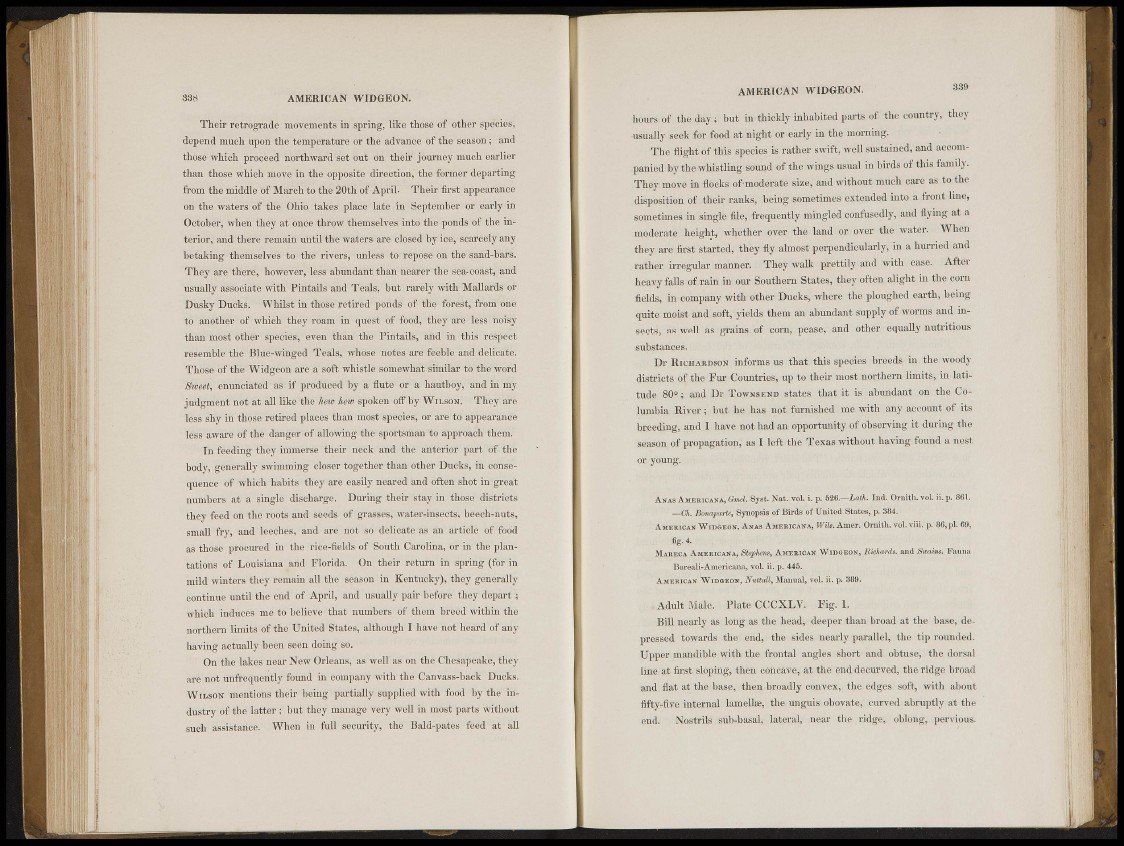
338 A M E R I C A N WIDGEON.
Their retrograda movements in spring, like those (if other spomos,
depend much upon, the temperature or the advance ill' tlio season ; and
those which proceed northward set out on their journey much earlier
than those which move in the opposite direction, the former departing
from the middle of March to the 20th of April. Their first appearance
on the waters of the Ohio, takes place late in September or early in
October, when they at once .throw Ihemsolves into the ponds fôfî the interior,
and there remain until the waters: are cliis'ed by ice,-scarcely any
betaking themselves to the rivers, unless to* repose on the sand bars.
They are there, however, less abundant than nearer the soUrCoHst, and
usually assodate with Pintails and Teals, but rarely with Mallards or
Dusky Ducks. Whilst in those retired ponds' of the'forest, from one
to another VI' Which they roam in quest of food, they are less tioi'sv
than most otiiòr spcêids, 'even than the Pintails, and in this respect,
resemble the Bluè-wingSd Teals, whoso nd||s are feeble and delffite.
ThosÉ of the Widgeon are a soft whistle, somewhat similar to the word
Sweet, enunciated as if produced by à flute or a hautboy, iitid in nit
judgment tiiif at all like the Item hew spoken oli' by WILSON. They arò
îêss shy in those retired places than mo>t spi.'cies, or are to appéàrSbké'é
liâs aware of the dangei-lof allowing the sportsman to approach tliom.
In feeding they immerse their neck and the anterior part, of the
body, generally èwimïning closer tojrc.thor than other Ducks, in consequence
of which habits they aire easily neared and often shot in'groat
numbers at a single discharge. During their stay- in those districts
they feed on the roots and seeds of grasses, vvatci'-mseets. beech-nuts,
small fry, and leeches, and are nofiw delicate as an artici» of food
as those procured in the rice-fields of South Carolina, or in the plantations
of Louisiana and Florida. On their return in spring (for ini'
mild winters ttey remain all the season in Kentucky), ftMy generally
continue until the end of April, and usually pair before they de.part ;
which induces me to believe that uumbcrs of them breed within the
northern limits of the United SfeteSV ¡although I have not* hoard of any
having actually beojitsfen doing so.
On the lakes near New Orleans, as well as on the Chesapeake, they
are not unfrequently found in company with the Canvass-baek Ducks.
WILSON: mentions their being partially supplied with food by the in -
dustry of the latter ; hut they manage very Well £a most parts Without
such assistance. When in full security, thè Bald-pates feed at all
A M E R I C A N WIDGEON. 339
hours of the day ; but in thioMy inhabited parts of the country, they
usually seek for food at night or early » h e morning.
The flight of tlHS species is rather swift, well sustained, and accompanied
by the whistling sound «1' the wings usual in birds of this family.
They: move in Hocks of-modernto size, and without much care as to the
,disposition of their ranks, being sometimes extended into a front line,
sometimes in single file:, frequently ro'muled confusedly, and flying at a
moderate height, whether over the land or over tlio water. When
they axe first started, they fly almost perpendicularly, in a hurried and
•rafter irregular manner. They walk prettily and with case. After
heavy falls of rain in our Southern States, they often alight, in the corn
fields, in company with other Ducks, where the ploughed earth, being
quite, moist and soft, yields them an abundant supply of worms and insects,
as well us grains of com, pease, and other- equally nutritious
substances,
Dr RICHARDSON informs: US that this spoc.ios breeds in the woody
districts of the. 1'ur Countries, up to their most northern limits, in latitude
i80fl <;. and Dr TOWNSEND states that it sis abundant on the Columbia
River ; but he has not furnished me with: any account of its
breeding, « I ® have not had an opportunity of observing it during the
season, of propagation, as I left the Texas without having found a nest
or young.
ANAS AMERICANA, Sm4, %st. Nat. vol. i, p. me.—Lath. Ind. Onuth. vol. ii. p. 861.
P'-ï-iSg; Bonaparte, Synopsis of liird» of tMted States, p. 384.
A M E R I C A N W IDGEON, ANAS AMERICANA, Wils. Amer. Ornitli. vol. viii. p. 8 6 , pi. 6 9 ,
'!%• i '
MARECA AMERICANA, Bteph^, AMERICAN WIDGEON, Bùàards. and Swams. Fauna
Boreali-Air.erioana, vol. ii. p. 445.
AMERICAN WIDGEON, Nutt/dl, Manual, vol. ii. p. 389.
. Adult.Male. Plate (X'CXI.V. i'ig. 1.
Bill nearly as long as the heady deeper than broad at the base, depressed
towards the: end, the sides nearly parallel, the tip rounded.
Upper mandible with the frontal angles short and obtuse, the dorsal
line: at first sloping, then concave, at thé end decurved, the ridge broad
and flat at the base, then broadly convex, the edges soft, with about
fifty-five: internal lamellae, the unguis obovate, curved, abruptly at the
end. Nostrils sub-basal, lateral, near the ridge, oblong, pervious.